Related Research Articles

Vampire literature covers the spectrum of literary work concerned principally with the subject of vampires. The literary vampire first appeared in 18th-century poetry, before becoming one of the stock figures of gothic fiction with the publication of Polidori's The Vampyre (1819), which was inspired by the life and legend of Lord Byron. Later influential works include the penny dreadful Varney the Vampire (1847); Sheridan Le Fanu's tale of a lesbian vampire, Carmilla (1872), and the most well known: Bram Stoker's Dracula (1897). Some authors created a more "sympathetic vampire", with Varney being the first, and more recent examples such as Moto Hagio's series The Poe Clan (1972-1976) and Anne Rice's novel Interview with the Vampire (1976) proving influential.

Bram Stoker's Dracula is a 1992 American vampire horror film produced and directed by Francis Ford Coppola and written by James V. Hart, based on the 1897 novel Dracula by Bram Stoker. The film stars Gary Oldman, Winona Ryder, Anthony Hopkins, Keanu Reeves, Richard E. Grant, Cary Elwes, Billy Campbell, Sadie Frost, and Tom Waits. Set in 19th-century England and Romania, it follows the titular vampire (Oldman), who falls in love with Mina Murray (Ryder), the fiancée of his solicitor Jonathan Harker (Reeves). When Dracula begins terrorizing Mina's friends, Professor Abraham Van Helsing (Hopkins), an expert in vampirism, is summoned to bring an end to his reign of terror. Its closing credits theme "Love Song for a Vampire", is written and performed by Annie Lennox.

Hannibal King is a character appearing in American comic books published by Marvel Comics. He first appeared as a supporting character in the title The Tomb of Dracula, issue #25.

Mark of the Vampire is a 1935 American horror film, starring Lionel Barrymore, Elizabeth Allan, Bela Lugosi, Lionel Atwill, and Jean Hersholt, and directed by Tod Browning. A series of deaths and attacks by vampires brings the eminent expert Professor Zelen to the aid of Irena Borotyn, who is about to be married. Her father, Sir Karell, died from complete loss of blood, with bite wounds on his neck, and it appears he may be one of the undead now plaguing the area.

R. M. Renfield is a fictional character who appears in Bram Stoker's 1897 Gothic horror novel Dracula. He is Count Dracula's deranged, fanatically devoted servant and familiar, helping him in his plan to turn Mina Harker into a vampire in return for a continuous supply of insects to consume and the promise of immortality. Throughout the novel, he resides in an asylum, where he is treated by Dr. John Seward.
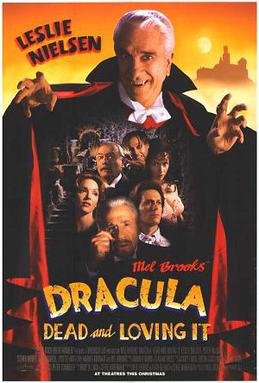
Dracula: Dead and Loving It is a 1995 comedy horror film directed by Mel Brooks and starring Leslie Nielsen. It is a spoof of Bram Stoker's novel Dracula and of some of the story's well-known adaptations.

Dracula is a 1931 American pre-Code supernatural horror film directed and co-produced by Tod Browning from a screenplay written by Garrett Fort and starring Bela Lugosi in the title role. It is based on the 1924 stage play Dracula by Hamilton Deane and John L. Balderston, which in turn is adapted from the 1897 novel Dracula by Bram Stoker. Lugosi portrays Count Dracula, a vampire who emigrates from Transylvania to England and preys upon the blood of living victims, including a young man's fiancée.
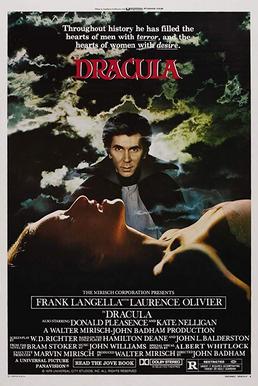
Dracula is a 1979 gothic horror film directed by John Badham. The film starred Frank Langella in the title role as well as Laurence Olivier, Donald Pleasence and Kate Nelligan.

Wilhelmina "Mina" Harker is a fictional character and the main female character in Bram Stoker's 1897 Gothic horror novel Dracula.
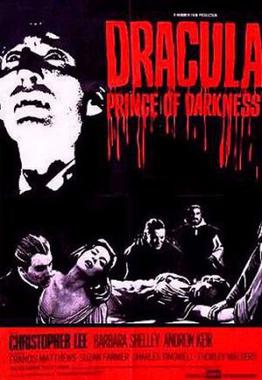
Dracula: Prince of Darkness is a 1966 British gothic supernatural horror film directed by Terence Fisher. The film was produced by Hammer Film Productions, and is the third entry in Hammer's Dracula series, as well as the second to feature Christopher Lee as Count Dracula, the titular vampire. It also stars Andrew Keir, Francis Matthews, and Barbara Shelley.

The Batman vs. Dracula is a 2005 American direct-to-video animated superhero-horror film based on The Batman television series. The film is a crossover with the 1897 horror novel Dracula. The film was released to DVD on October 18, 2005, and made its television debut on Cartoon Network's Toonami block on October 22. In the film, the Batman races to save Gotham City from his most challenging foe yet: the legendary vampire Count Dracula, who hatches a plot together to enslave the city and create a race of vampires along with his two new henchmen, the Penguin and the Joker. It was released on DVD as a tie-in with the live action Batman Begins.
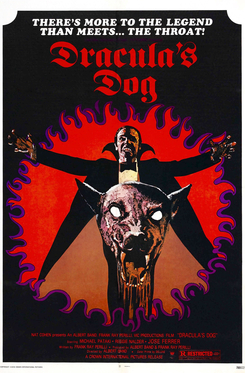
Dracula's Dog, also known as Zoltan... Hound of Dracula, is a 1977 American supernatural horror film directed by Albert Band and starring Michael Pataki and José Ferrer. Its plot revolves around a Doberman Pinscher who is turned into a vampire by a member of the Dracula family, who is also a vampire.

Blood of the Vampire is a 1958 British colour horror film directed by Henry Cass and starring Donald Wolfit, Barbara Shelley, and Vincent Ball. The film was produced by Robert S. Baker and Monty Berman for Tempean Films, from a screenplay by Jimmy Sangster.

Universal Classic Monsters is a home video line based on a series of horror films primarily produced by Universal Pictures from the 1930s to the 1950s. Although not initially conceived as a franchise, the enduring popularity and legacy of the films and the characters featured in them has led the studio to market them under the collective brand name of Universal Studios Monsters. Steve Jones of USA Today described Universal's most famous monsters as "pop culture icons", specifically Dracula, Frankenstein, the Mummy, and the Wolf Man.

Vampira is a 1974 British comedy horror film directed by Clive Donner, and starring David Niven and Teresa Graves. This spoof of the vampire genre was re-titled Old Dracula for release in the United States, in an attempt to ride the success of Young Frankenstein.

Dracula, also known as Bram Stoker's Dracula and Dan Curtis' Dracula, is a 1974 British made-for-television gothic horror film and adaptation of Bram Stoker's 1897 novel Dracula. It was written by Richard Matheson and directed by Dark Shadows creator Dan Curtis, with Jack Palance in the title role. It was the second collaboration for Curtis and Palance after the 1968 TV film The Strange Case of Dr. Jekyll and Mr. Hyde.

The Return of Dracula is a 1958 American horror film directed by Paul Landres, and starring Francis Lederer, Norma Eberhardt, and Ray Stricklyn. It follows Dracula, who murders an artist aboard a train in Central Europe, and proceeds to impersonate the man, traveling to meet with his extended family in a small California town. The film is primarily in black and white, aside from one brief color sequence.
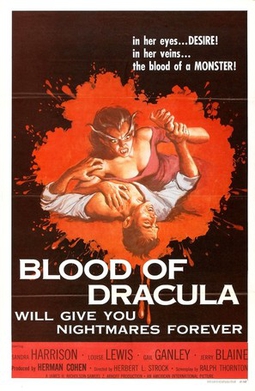
Blood of Dracula is a 1957 American black-and-white horror film directed by Herbert L. Strock, and starring Sandra Harrison, Louise Lewis and Gail Ganley. It was co-written by Aben Kandel and Herman Cohen.
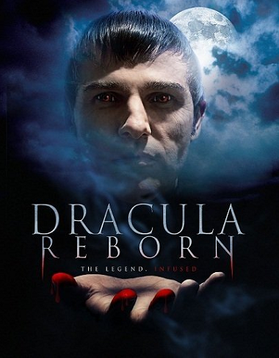
Dracula Reborn is a 2012 vampire-themed direct-to-video horror film, directed and written by Patrick McManus, making his feature film directorial debut. Produced by Ray Haboush, the film stars Corey Landis, Victoria Summer, Krash Miller, Stuart Rigby and Keith Reay. It is a modernized, loosely based take on Bram Stoker's 1897 novel Dracula, taking place in Los Angeles, California, where a wealthy Count Dracula looks to purchase an abandoned building and pursue the wife of his realtor, Jonathan Harker.

Lady Dracula is a 1977 West German comedy horror film, directed by Franz Josef Gottlieb and starring Evelyne Kraft, Brad Harris, and Theo Lingen in his final film appearance.
References
Citations
- 1 2 3 4 5 6 "Catalog: Deafula". American Film Institute . Retrieved 6 April 2020.
- 1 2 3 4 5 6 7 Sutton, Travis (2017). "Avenging the Body: Disability in the Horror Film". In Benshoff, Harry M. (ed.). A Companion to the Horror Film. John Wiley & Sons. pp. 83–86. ISBN 978-1119335016 . Retrieved 6 April 2020– via GoogleBooks.
- 1 2 "The Global Vampire". Deaf Life Magazine. Vol. 9. 1996. p. 196. Retrieved 7 April 2020– via GoogleBooks.
- ↑ Gertz, Genie; Boudreault, Patrick (2015). The SAGE Deaf Studies Encyclopedia. SAGE Publications. ISBN 978-1506300771 . Retrieved 9 April 2020– via GoogleBooks.
- 1 2 3 4 5 6 Newman, Kim (2018). Kim Newman's Video Dungeon. California: Titan Books. ISBN 978-1785657474 . Retrieved 6 April 2020– via GoogleBooks.
- ↑ Baldwin, Stephen C. (1994). Pictures in the Air: The Story of the National Theatre of the Deaf. Gallaudet University Press. p. 31. ISBN 1563681404 . Retrieved 6 April 2020– via GoogleBooks.
- 1 2 Albright 2012, p. 285.
- ↑ "Sign Language Film Opens Thursday". The Columbian. January 15, 1975. p. 26.
- ↑ Kruger, Art (May 1975). "Sporting Around". The Deaf American. Vol. 27, no. 9. National Association of the Deaf. p. 20 . Retrieved 9 April 2020– via Internet Archive.
- ↑ "Retrospective: Blood Simple". New York Magazine . 21 April 1997. p. 68. Retrieved 7 April 2020– via GoogleBooks.
- ↑ Huyser, Kevin J.; Benjamin, Michael J.; Kuhn, Karl W.; Davis, Bobbi J.W.; Patoir, Steven R.; Sharp, Gregg S. (January 2004). "Government contract and fiscal law symposium; acquisition flexibility: friend or foe?". Army Lawyer. Judge Advocate General's School. Retrieved 6 April 2020– via Gale Academic OneFile.
- ↑ Del Valle, David (1999). "Deafula". Psychotronic Video. Vol. 29. Retrieved 7 April 2020– via Internet Archive.
General sources
- Albright, Brian (2012). Regional Horror Films, 1958–1990: A State-by-State Guide with Interviews. Jefferson, North Carolina: McFarland. ISBN 978-1-476-60042-0.